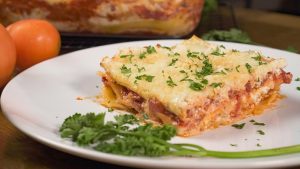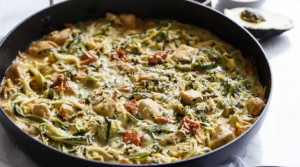Lasagna, a classic Italian dish, is renowned for its hearty flavors and comforting layers. This version adds a unique twist by incorporating sausage and eggplant. The sausage brings a robust, full-bodied flavor that complements the delicate, slightly sweet taste of the eggplant. The result is a rich, savory lasagna that's a delightful deviation from the traditional recipe.
Eggplant is a key ingredient in this recipe. If it's not commonly found in your home, you might need to plan a trip to the supermarket. When choosing eggplants, look for ones that are firm and have a glossy skin. Avoid ones with blemishes or soft spots. Also, for the sausage, this recipe calls for beef sausage, but you can substitute it with any variety you prefer, such as pork or chicken.
Ingredients for Sausage and Eggplant Lasagna
Eggplants: Eggplants add a unique texture and slightly sweet flavor to the lasagna.
Olive oil: It is used for roasting the eggplants and sautéing the onions.
Salt: Accentuates the flavors of the other ingredients.
Onion: It provides a sweet and savory depth to the sauce.
Beef sausages: They add a hearty, robust flavor to the lasagna. You can substitute it with your preferred variety.
Garlic cloves: It gives an intense and aromatic flavor.
Crushed tomatoes: They form the base of the pasta sauce.
Sugar: It balances the acidity of the tomatoes.
Vegetable stock powder: Enhances the overall flavor of the sauce.
Basil leaves: They provide a fresh, herbal note.
Mozzarella cheese: It gives the lasagna its characteristic gooey, stretchy texture.
Parmesan cheese: It adds a salty, nutty flavor.
Ricotta cheese: Ricotta cheese contributes a creamy texture to the lasagna.
Basil pesto: It gives an intense, herby flavor.
One reader, Bidget Franklin says:





This sausage and eggplant lasagna recipe is a game-changer! The combination of flavors is simply divine. The roasted eggplant adds a delightful twist, and the layers of cheese and sausage create a rich and satisfying dish. It's a must-try for anyone looking to elevate their lasagna game!
Techniques Required for Making Lasagna
How to roast eggplant slices: Arrange the eggplant slices in a single layer on oven trays, drizzle with olive oil, and sprinkle with salt. Roast for 20 minutes at 356°F, turning after 10 minutes, or until tender and golden. Set aside to cool.
How to make the tomato sauce: Heat oil in a saucepan over medium heat. Add onion and cook until lightly golden. Add the sausages and fry until browned and cooked through. Stir in garlic and cook until fragrant. Add the tomatoes and bring to a simmer. Reduce heat to low and simmer for 10 minutes or until the sauce thickens. Season with salt, sugar, stock powder, and basil.
How to layer the lasagna: Spread a third of the tomato sauce over the base of the pan. Add the roasted eggplant slices, then sprinkle with cheese. Layer with another portion of sauce, eggplant, and mozzarella cheese. Repeat layering with eggplant, sauce, and half of the ricotta. Finish the top layer with sauce and the remaining ricotta. Sprinkle with cheese.
How to bake the lasagna: Preheat the oven to 356°F. Grease a 6cm square ovenproof dish. Bake the assembled lasagna for 20 minutes or until the cheese is golden and bubbling. Serve.
How To Make Sausage Eggplant Lasagna
Sausages and eggplants are probably the last ingredients you’ll expect in a lasagna. For this lasagna recipe, we are combining them for an amazing dish.
Serves:
Ingredients
- 3pcseggplants
- 2tbspolive oil
- 1tspsalt
- 1cuponion
- 19ozbeef sausaessliced
- 1tbspgarlic cloves
- 14ozcrushed tomatoes
- 1tbspsugar
- 1tspvegetable stock powder
- ½cupbasil leaveschopped
- 2cupsmozzarella cheeseshredded
- ½cupParmesan cheesegrated
- 9ozricotta cheese
- 4tbspbasil pesto
Instructions
-
Preheat oven to 356 degrees F. Spray 2 oven trays with cooking oil spray. Arrange eggplant slices in a single layer on oven trays; drizzle with the olive oil and sprinkle with salt.
-
Toss to evenly coat with your hands. Roast for 20 minutes, turning after 10 minutes, or until tender and golden. Set aside to cool.
-
Heat oil in a saucepan over medium heat. Add onion and cook for 5 minutes or until lightly golden. Add the sausages and fry until browned and cooked through. Stir garlic through and cook until fragrant.
-
Add the tomatoes and bring to a simmer. Reduce heat to low and simmer for 10 minutes or until sauce thickens. Season with salt to taste, a pinch of sugar, stock powder, and basil.
-
Place ricotta, pesto, salt and pepper in a bowl and mix until well combined.
-
Grease a 6cm square ovenproof dish. Spread a third of the tomato sauce over the base of the pan. Add the eggplant slices over the top.
-
Sprinkle the cheese over the eggplant. Layer with another layer of sauce, eggplant, and mozzarella cheese. Repeat layering with eggplant, sauce, and half of the ricotta.
-
Finish the top layer with sauce and the remaining ricotta. Sprinkle with cheese. Bake for 20 minutes or until the cheese is golden and bubbling. Serve.
Nutrition
- Calories: 703.19kcal
- Fat: 43.17g
- Saturated Fat: 22.06g
- Trans Fat: 0.22g
- Monounsaturated Fat: 14.18g
- Polyunsaturated Fat: 1.96g
- Carbohydrates: 30.86g
- Fiber: 10.18g
- Sugar: 16.90g
- Protein: 52.14g
- Cholesterol: 164.66mg
- Sodium: 1442.38mg
- Calcium: 823.10mg
- Potassium: 1327.85mg
- Iron: 4.26mg
- Vitamin A: 264.45µg
- Vitamin C: 14.89mg
Crucial Technique Tips for Crafting the Perfect Lasagna
When roasting the eggplant, make sure to flip them halfway through the cooking process. This ensures that both sides are evenly cooked and tender. Additionally, when layering the lasagna, ensure each layer is evenly spread. This will result in a balanced flavor and texture in every bite. Lastly, when baking the lasagna, keep an eye on the cheese on top. If it's browning too quickly, you can loosely cover the dish with aluminum foil to prevent it from burning while the rest of the lasagna continues to cook.
Time-Saving Tips for Preparing Sausage and Eggplant Lasagna
Prep ahead: Prepare the tomato sauce and ricotta mixture a day in advance to save time on the day of making the lasagna.
Use store-bought: Consider using store-bought tomato sauce and pesto to cut down on prep time without compromising on flavor.
Batch cooking: Cook extra sausage and freeze it in portions for future use in recipes like this lasagna to save time on busy days.
Mandoline slicer: Use a mandoline slicer to quickly and uniformly slice the eggplant, saving time on prep work.
Assembly line: Set up an assembly line with all the ingredients prepped and ready to go to streamline the layering process of the lasagna.
Substitute Ingredients For Sausage Eggplant Lasagna Recipe
beef sausages - Substitute with plant-based sausages: Plant-based sausages provide a similar texture and flavor to traditional beef sausages, making them a suitable substitute for a vegetarian or vegan option.
mozzarella cheese - Substitute with vegan mozzarella cheese: Vegan mozzarella cheese made from plant-based ingredients can be used for a dairy-free alternative while still providing a creamy and melty texture.
ricotta cheese - Substitute with tofu ricotta: Tofu ricotta can be used as a dairy-free alternative, providing a similar creamy texture and mild flavor to traditional ricotta cheese.
parmesan cheese - Substitute with nutritional yeast: Nutritional yeast offers a cheesy, umami flavor and can be used as a dairy-free substitute for parmesan cheese, adding a savory element to the dish.
basil pesto - Substitute with sun-dried tomato pesto: Sun-dried tomato pesto can provide a flavorful alternative to basil pesto, adding a rich and tangy dimension to the dish.
Presenting Your Sausage and Eggplant Lasagna
Elevate the layers: Create a visually stunning presentation by carefully layering the roasted eggplant with the rich sausage and tomato sauce, allowing each layer to shine through.
Garnish with fresh basil: Add a pop of color and a burst of fresh flavor by delicately scattering vibrant basil leaves over the top of the lasagna just before serving.
Incorporate cheese artistry: Artfully arrange the mozzarella and parmesan cheese on the top layer, creating a visually appealing pattern that showcases the richness of the dish.
Use a square mold for precision: Opt for a square ovenproof dish to create clean, defined edges that exude elegance and precision when presenting the lasagna to the judges.
Drizzle with basil pesto: Finish the presentation by drizzling a small amount of vibrant basil pesto in a decorative pattern on the plate, adding a touch of sophistication and a burst of herbal flavor to the dish.
Essential Kitchen Tools for Making Lasagna
- Oven: An appliance used for baking, roasting, and heating food.
- Saucepan: A deep cooking pan with a handle and a lid, used for making sauces and heating liquids.
- Ovenproof dish: A dish that can be safely used in an oven for baking or roasting.
- Cooking oil spray: A spray used to grease pans and trays to prevent food from sticking.
- Food processor: A kitchen appliance used for chopping, blending, and pureeing ingredients.
- Mixing bowl: A bowl used for mixing ingredients together.
- Spatula: A kitchen tool with a broad, flat, flexible blade used for mixing, spreading, and lifting.
- Oven trays: Flat, rectangular metal trays used for baking and roasting in the oven.
Storing and Freezing Your Homemade Lasagna
Allow the lasagna to cool completely before storing or freezing. This will prevent condensation from forming and making the dish soggy.
To store in the refrigerator, cover the lasagna tightly with plastic wrap or aluminum foil. It will keep well for up to 4 days in the fridge.
For longer storage, freeze the lasagna. Wrap the dish securely in plastic wrap, followed by a layer of aluminum foil. Label the package with the date and contents.
Alternatively, cut the lasagna into individual portions and wrap each piece separately before freezing. This allows for easy reheating of single servings.
Frozen lasagna can be stored for up to 2 months in the freezer.
To reheat refrigerated lasagna, preheat the oven to 350°F (175°C). Cover the dish with foil and bake for 20-30 minutes, or until heated through.
For frozen lasagna, thaw it overnight in the refrigerator before reheating. If reheating directly from frozen, increase the baking time to 45-60 minutes, keeping the dish covered with foil for most of the cooking time to prevent drying out.
If you prefer a crispy top on your reheated lasagna, remove the foil for the last 5-10 minutes of baking.
How To Reheat Lasagna Leftovers
To reheat leftover sausage and eggplant lasagna, preheat your oven to 350°F (175°C). This temperature ensures that the lasagna heats through evenly without drying out or burning the edges.
Cover the lasagna with aluminum foil before placing it in the oven. The foil helps to trap moisture, preventing the pasta from becoming dry and the cheese from burning. If you prefer a crispy top layer, remove the foil for the last 5-10 minutes of reheating.
Place the covered lasagna in the preheated oven and reheat for 20-30 minutes, depending on the size of the portion and the starting temperature of the lasagna. If the lasagna was stored in the refrigerator, it may take longer to reheat than if it was at room temperature.
To check if the lasagna is heated through, insert a knife or a fork into the center of the dish. If the utensil comes out hot to the touch, the lasagna is ready to serve. If not, continue reheating in 5-minute increments until fully warmed.
For a quicker reheating method, you can use a microwave. Place a single serving of lasagna on a microwave-safe plate and heat it on high power for 1-2 minutes. Check the lasagna and stir gently to distribute the heat evenly. Continue microwaving in 30-second intervals until the lasagna is steaming hot throughout.
If you have stored the lasagna in the freezer, it's best to thaw it in the refrigerator overnight before reheating. This allows for more even reheating and reduces the risk of cold spots in the center of the dish. Once thawed, follow the oven or microwave reheating instructions above.
To maintain the best texture and flavor, consume reheated sausage and eggplant lasagna within 2-3 days of initial preparation. Store any remaining leftovers in an airtight container in the refrigerator.
Fascinating Facts About Lasagna
The eggplant used in this recipe is a versatile vegetable that is low in calories and high in fiber, making it a great addition to a healthy diet. Eggplants are also a good source of vitamins and minerals, including vitamin C, vitamin K, vitamin B6, and potassium. They are also rich in antioxidants, which can help protect the body from damage caused by free radicals. So, including eggplant in your lasagna not only adds a delicious flavor and texture but also provides a nutritional boost to the dish.
Is Making Lasagna at Home Cost-Effective?
This sausage and eggplant lasagna recipe is quite cost-effective for a household. The combination of affordable ingredients such as eggplant, sausages, and cheeses makes it a budget-friendly option. The use of vegetables and meat provides a good balance of nutrients, making it a wholesome and satisfying meal. The approximate cost for a household of 4 people would be around $20, making it an economical choice. Overall Verdict: 9/10.
Is This Lasagna Recipe Healthy or Unhealthy?
The sausage and eggplant lasagna recipe is a delicious and comforting dish, but it may not be the healthiest option due to several factors:
- High in fat: The recipe includes a significant amount of cheese (mozzarella, parmesan, and ricotta) and beef sausages, which are high in saturated fat. Excessive consumption of saturated fat can lead to increased risk of heart disease and other health issues.
- Refined carbohydrates: The recipe does not specify the type of lasagna noodles used, but if they are made from refined flour, they may lack fiber and essential nutrients.
- High in sodium: The recipe calls for added salt, and the sausages and cheeses are also high in sodium. Excessive sodium intake can lead to high blood pressure and other health problems.
- Limited vegetables: While the recipe includes eggplant, it could benefit from the addition of more diverse vegetables to increase its nutritional value.
To make this recipe healthier, consider the following suggestions:
- Use lean turkey or chicken sausages instead of beef sausages to reduce the saturated fat content
- Incorporate whole-grain lasagna noodles to increase the fiber and nutrient content
- Reduce the amount of cheese used, or opt for low-fat versions of mozzarella and ricotta
- Add more vegetables to the recipe, such as spinach, zucchini, or bell peppers, to boost the nutritional value and fiber content
- Use low-sodium crushed tomatoes and reduce the amount of added salt to control sodium intake
- Replace some of the ricotta cheese with pureed tofu for a protein-rich, lower-fat alternative
- Serve the lasagna with a side salad to increase the overall vegetable intake of the meal
Editor's Thoughts on This Delightful Lasagna Recipe
The combination of roasted eggplant, flavorful sausage, and creamy cheeses in this lasagna recipe creates a rich and satisfying dish. The use of basil pesto adds a delightful herby note, complementing the savory flavors. The layering technique ensures a well-balanced distribution of ingredients, resulting in a harmonious blend of textures and tastes. Overall, this recipe offers a delicious twist on traditional lasagna, making it a delightful choice for a hearty and comforting meal.
Enhance Your Sausage Eggplant Lasagna Recipe with These Unique Side Dishes:
Delicious Alternatives to Sausage and Eggplant Lasagna
Appetizer and Dessert Ideas to Complement Your Lasagna
Why trust this Sausage Eggplant Lasagna Recipe:
This recipe offers a delightful twist on the classic lasagna, incorporating the rich flavors of sausage and eggplant. The combination of savory sausage and roasted eggplant creates a harmonious blend of textures and tastes. The use of ricotta cheese and basil pesto adds a creamy and aromatic element, enhancing the overall dish. The careful layering of ingredients and the inclusion of quality mozzarella and parmesan cheese ensure a satisfying and indulgent experience. Trust in the balance of flavors and the expertise behind this recipe to elevate your dining experience.
Was this page helpful?
Have your own special recipe to share? Submit Your Recipe Today!














